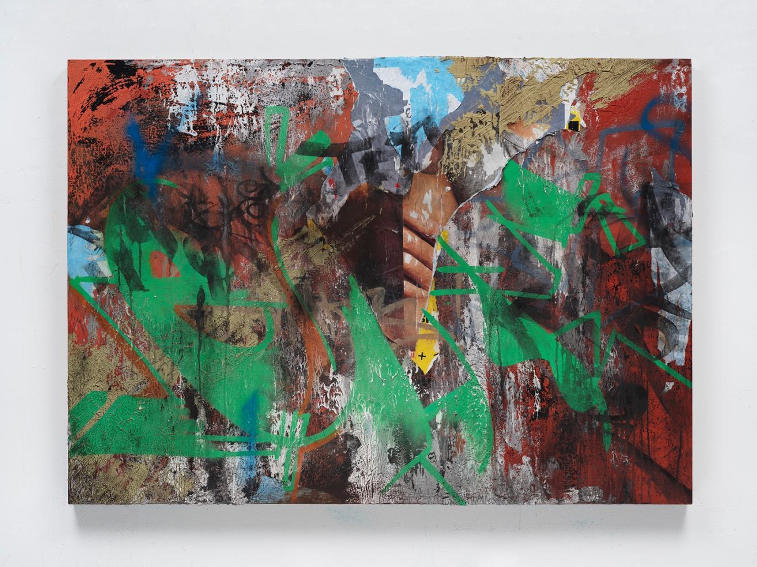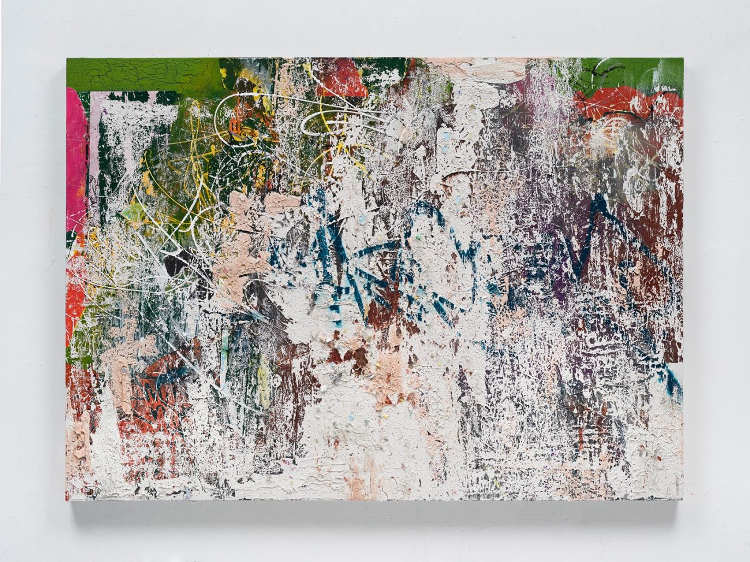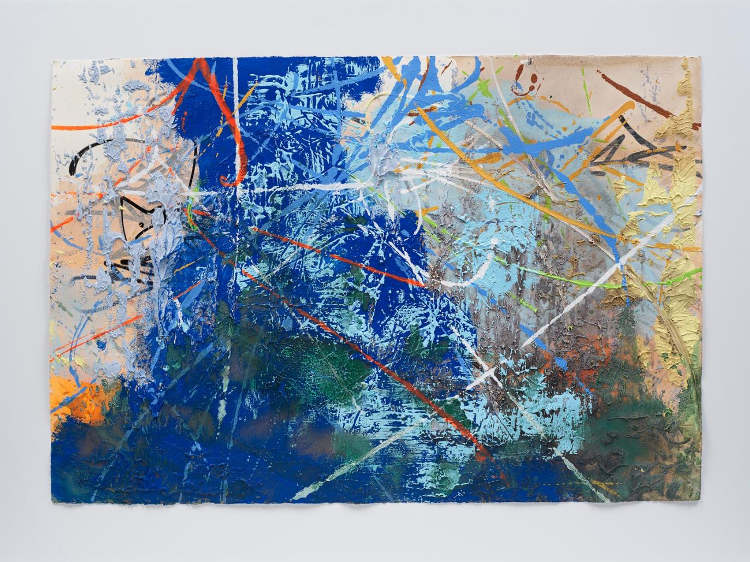
José Parlá's Abstract Love Letter To New York City
José Parlá is quickly becoming one of the most beloved public artists in the world. His first public mural, unveiled early in 2011, graced an interior wall of a condominium development in Toronto. Dominating the room with its deep brown and orange color fields, and stark, white, calligraphic scribbles, the layered and enormously complex mural brought all of the undulating energy and visual diversity of the modern city to life. Parlá fostered the visual voice that made that mural so powerful while painting graffiti and tagging the urban walls of Miami as a child. After graduating art school, he moved to The Bronx, New York City, where he earned a living painting album covers for Hip Hop artists. Of course, thousands of artists with roots in street art later show their work in institutional spaces, but there is something unique about what Parlá does. He is concerned as much with the surface itself as whatever he chooses to add to it. He understands walls as historical documents—stories of the cycles of contemporary urban life embedded within layers of dirt, grime, paper, glue, paint, rust, blood and sweat. His paintings strive to express that same urban totality by mixing non-representational, formalist, abstract elements such as color, line, and texture, with a primordial soup of representational elements, such as text and collage. Parlá is so good at communicating the soul of the city that he was one of the first artists invited to create large-scale works for One World Trade Center. The mural he created for that project, “One: Union of the Senses,” is believed to be the biggest painting in New York, measuring 4.5 x 27.5 meters. In 2018, Parlá painted an even bigger mural titled “Amistad América”—measuring 7.5 x 49.5 meters—at the University of Texas at Austin. His work is not all about scale, however. This summer, The Bronx Museum will welcome Parlá home with his first solo museum exhibition in New York. That exhibition will consist of a new body of human-scale paintings and sculpture. The title—José Parlá: It's Yours—perfectly expresses the community-focused roots that nurtured the mature artist Parlá has become.
Freestyle Mythmaking
The fastest way to understand what Parlá does is to watch him work. He documented the creation of his mural for One World Trade Center in a film of the same name—One: Union of the Senses—which is currently available on YouTube. It shows Parlá climbing to the top of a tall ladder, starting a gestural mark on the canvas, then jumping off the ladder, his brush trailing on the canvas as he falls. We see his fingers clawing into his impasto medium, as layer after layer of paint, paper and glue builds up on the surface. Throughout the film, we also see glimpses of time-worn, graffiti-covered city walls and street performers, juxtaposed with shots of Parlá working on his mural. Every movement, every substance, every natural force that we see at work in the city finds its way into his method, until the finished mural finally possesses something akin to the look of history.

JoseÌ ParlaÌ - Social Visual, 2020 © Acrylic, ink, collage, enamel, plaster and oil paint on canvas. Photo courtesy of Parlá Studios.
Like his murals, the paintings Parlá will debut in his Bronx Museum exhibition contain visual echoes of the history of their making. Yet, they also show an artist who is evolving towards something even deeper. The stark palette and frenetic linear qualities of “The Flow of Sovereignty” (2020)—a calligraphic explosion of white, gestural markings on a black surface—are visually reminiscent of the breakthrough white canvases of Cy Twombly. Yet, Parlá raises the stakes on Twombly, expressing not only the formal aspects of line and gesture found in graffiti, but also the larger social context of graffiti as culture. Meanwhile, the epic “It's Yours: The International Illegal Construct Against Indigenous People” (2020), reveals the interest Parlá has in myth. Unlike the Abstract Expressionists, his mythmaking is not rooted in classical stories of bygone times. Rather, Parlá is a freestyle mythmaker, articulating the muted cries of everyday legends.

JoseÌ ParlaÌ - The Myth Seekers, 2020 © Acrylic, ink, collage, enamel, plaster and oil paint on canvas. Photo courtesy of Parlá Studios.
New Urban Realism
The everyday authenticity Parlá expresses in his new work brings to mind a century-old phrase, Urban Realism, which was first used to describe a group of American artists working in the 1920s, mostly in New York City. Epitomized by a loosely connected group known as The Ash Can School, their aesthetic glorified the everyday lives of poor, urban, working people. There was nothing abstract about the pictures the Urban Realists painted, except perhaps the mood the works captured. Their paintings felt authentic, meaning when poor, urban, working class audiences saw these paintings, they recognized themselves in them. Urban Realism flipped the usual cultural imperialism of the fine art market, causing critics to mock these poor, urban artists who painted pictures of poor, urban people for poor, urban people to enjoy. One critic coined the term Ash Can School as a derisive comment about the work, but the artists embraced the ridiculous insult, considering it a compliment.

JoseÌ ParlaÌ - Waves of Displacement, 2020 © Acrylic, ink, collage, enamel, plaster and oil paint on canvas. Photo courtesy of Parlá Studios.
It is no stretch to connect The Ash Can School with contemporary urban graffiti, which has always been part of urban, working class culture. Like Urban Realism, graffiti is fundamentally objective—it contains messages, however much they are intended only for those who can read them. Yet, it also communicates something abstract: that same feeling of authenticity that the Urban Realists conveyed. It makes sense Parlá moved to The Bronx when arriving in New York—the first galleries that ever showed graffiti art, such as Fashion Moda, were located in that borough. Parlá may not be painting pictures of contemporary urban people, but he is absolutely expressing a material reality that we recognize. That reality is in the layers of calligraphic writing that covers his surfaces; his gestural swoops, which echo everything from the movement of breezes through alleyways, to the flips and twirls of Showtime dancers on the train. The scrawl of his hand prints through his impasto paints echoes the same sentiment as 60,000-year-old handprints on a cave wall—that someone with a creative mind was here, and had legends worth sharing with the future. José Parlá: It's Yours is currently scheduled to run 9 September 2020 through 10 January 2021 at The Bronx Museum, COVID-19 restrictions allowing.
Featured image: JoseÌ ParlaÌ - Done Up With Finesse, 2020 © Acrylic, ink, collage, enamel, plaster and oil paint on canvas. Photo courtesy of Parlá Studios
All images used for illustrative purposes only
By Phillip Barcio






